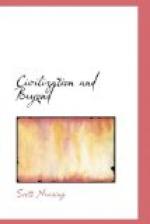In a broad view, sociology includes politics, economics and ideology. For the purposes of our social analysis, we have divided the field into four separate categories, beginning with politics, continuing through economics and drawing our study together under the general headings of sociology and ideology.
No civilization that we have studied can be regarded as an intentional or projected or planned enterprise. On the contrary, civilizations have developed and matured in true pragmatic fashion, taking one step after another because their predecessors had followed this course or because, given the human urges and the available natural and social opportunities, the next step seemed to be determined by previous steps plus the momentum of the enterprise. In the course of this development an ideology was built up and modified in such a way as to justify and strengthen the entire project.
When William Penn received a grant of land from the English Crown, he was already committed, ideologically, by the Quaker faith to Quaker methods. Without ever seeing his proposed home across the Atlantic he drew up a plan for his City of Brotherly Love (Philadelphia), and for the organization and conduct of his enterprise. The entire project was formulated in Penn’s mind and put on paper. This is a good example of an intentional community.
No civilization so far as I know, has followed such a sequence. Certainly in the civilizations with which we are most familiar, political and economic forces, the principles of necessity and availability have led to the formulation of an ideology that would justify and promote the interests of the social group which was controlling and directing the community or communities in which the civilization was maturing.
Perhaps it would be more accurate to say that each of the component elements making up the expanding civilization—each people, city, state, nation, empire—developed its own total culture pattern, subject to the pressures mutually exerted by neighboring communities. The aggregate of these culture patterns, separately and often antagonistically matured, comprised a lesser totality called an empire and a larger totality called a civilization. It is with this larger totality that we are concerned.
We propose to analyse the sociology of civilization under the following headings: (1) the structure or anatomy; (2) the function, physiology, or process; (3) motive forces in civilization; (4) contradictions and conflicts, with a final section on the life cycle of civilization.
The structure of human society consists of specialized economic, political, administrative and cultural groupings assembled and maintained in relationships that supply necessities, conveniences, comforts, luxuries for the individuals, together with capital goods and services for the social groups composing the civilization.




